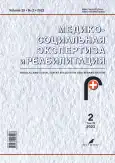Тенденции численности населения трудоспособного и старше трудоспособного возраста в Республике Дагестан
- Авторы: Алиев А.К.1,2, Владимирова О.Н.3, Пузин С.Н.4,5, Горяйнова М.В.3
-
Учреждения:
- Первый Московский государственный медицинский университет имени И.М. Сеченова (Сеченовский Университет)
- Южный окружной медицинский центр, Махачкалинская клиническая больница
- Санкт-Петербургский институт усовершенствования врачей-экспертов
- Федеральный научно-клинический центр реаниматологии и реабилитологии
- Российская медицинская академия непрерывного профессионального образования
- Выпуск: Том 25, № 2 (2022)
- Страницы: 113-123
- Раздел: ОРИГИНАЛЬНОЕ ИССЛЕДОВАНИЕ
- URL: https://journal-vniispk.ru/1560-9537/article/view/233352
- DOI: https://doi.org/10.17816/MSER109389
- ID: 233352
Цитировать
Аннотация
Обоснование. Анализ состояния и тенденций численности населения, изучение возрастных особенностей и иные показатели являются основой формирования целевых программ социальной поддержки граждан трудоспособного и старше трудоспособного возраста на уровне субъекта Российской Федерации.
Цель исследования ― выявление демографических особенностей населения в Республике Дагестан и определение современных тенденций демографического развития региона.
Материал и методы. Объект исследования ― население трудоспособного и старше трудоспособного возраста в Республике Дагестан. Источники ― официальные данные территориального органа Федеральной службы государственной статистики по Республике Дагестан. Методы исследования: аналитический, методы экспертных оценок, статистического и демографического анализа, которые обеспечили обоснованность научных результатов. Исследование лонгитюдинальное сплошное, достоверное. При подборе линии тренда динамики численности взрослого населения в Республике Дагестан в 1999–2020 гг. в Excel произведён автоматический расчёт значения величины R2, которая характеризует достоверность аппроксимации: чем ближе значение R2 к единице, тем надёжнее линия тренда аппроксимирует исследуемый процесс (в исследовании R2=0,902).
Результаты. Показатели демографии населения отражают состояние общественного здоровья, являясь важным критерием для оценки трудоспособности населения, качества жизни, уровня социально-экономического развития общества. Выявлены периоды значительного роста: в 2004 г. показатель по наглядности составил 122,7% при показателе наглядности в 2003 г. 103,7%, т.е. численность населения увеличилась на 18,3%, темп прироста в 2004 г. составил 18,3%; в 2011 г. показатель наглядности составил 140,65 при показателе наглядности в 2003 г. 129,1% и темпе прироста 8,9%.
Заключение. Полученные данные анализа численности населения трудоспособного и старше трудоспособного возраста в Республике Дагестан имеют практическое значение для министерств и ведомств, занимающихся разработкой мероприятий по социальной поддержке граждан.
Ключевые слова
Полный текст
Открыть статью на сайте журналаОб авторах
Ахмед Курбанович Алиев
Первый Московский государственный медицинский университет имени И.М. Сеченова (Сеченовский Университет); Южный окружной медицинский центр, Махачкалинская клиническая больница
Автор, ответственный за переписку.
Email: m_b@uomc-mail.ru
ORCID iD: 0000-0003-4957-6724
SPIN-код: 7505-5618
MD
Россия, Москва; МахачкалаОксана Николаевна Владимирова
Санкт-Петербургский институт усовершенствования врачей-экспертов
Email: vladox1204@yandex.ru
ORCID iD: 0000-0001-6692-2882
SPIN-код: 6405-4757
д.м.н., профессор
Россия, Санкт-ПетербургСергей Никифорович Пузин
Федеральный научно-клинический центр реаниматологии и реабилитологии; Российская медицинская академия непрерывного профессионального образования
Email: s.puzin2012@yandex.ru
ORCID iD: 0000-0002-9711-3532
SPIN-код: 2206-0700
д.м.н., профессор, академик РАН
Россия, Москва; МоскваМарина Владимировна Горяйнова
Санкт-Петербургский институт усовершенствования врачей-экспертов
Email: marinagoryainova@mail.ru
ORCID iD: 0000-0001-8904-8614
SPIN-код: 5189-8241
Россия, Санкт-Петербург
Список литературы
- Абдулманапов П.Г. Влияние экономических изменений на развитие демографических процессов в Республике Дагестан // Региональные проблемы преобразования экономики. 2018. № 12. С. 275–282. doi: 10.26726/1812-7096-2018-11-275-282
- Владимирова О.Н. Система комплексной реабилитации инвалидов с ограничением мобильности: Автореф. дис. … докт. мед. наук. Москва, 2020. 48 с.
- Владимирова О.Н., Башкирева А.С., Коробов М.В., и др. Инвалидность как медико-социальный индикатор состояния здоровья и постарения населения в Российской Федерации // Успехи геронтологии. 2017. Т. 30, № 3. С. 398–402.
- Регионы России. Социально-экономические показатели: статистический сборник. Москва: Росстат, 2018. 1162 с.
Дополнительные файлы














